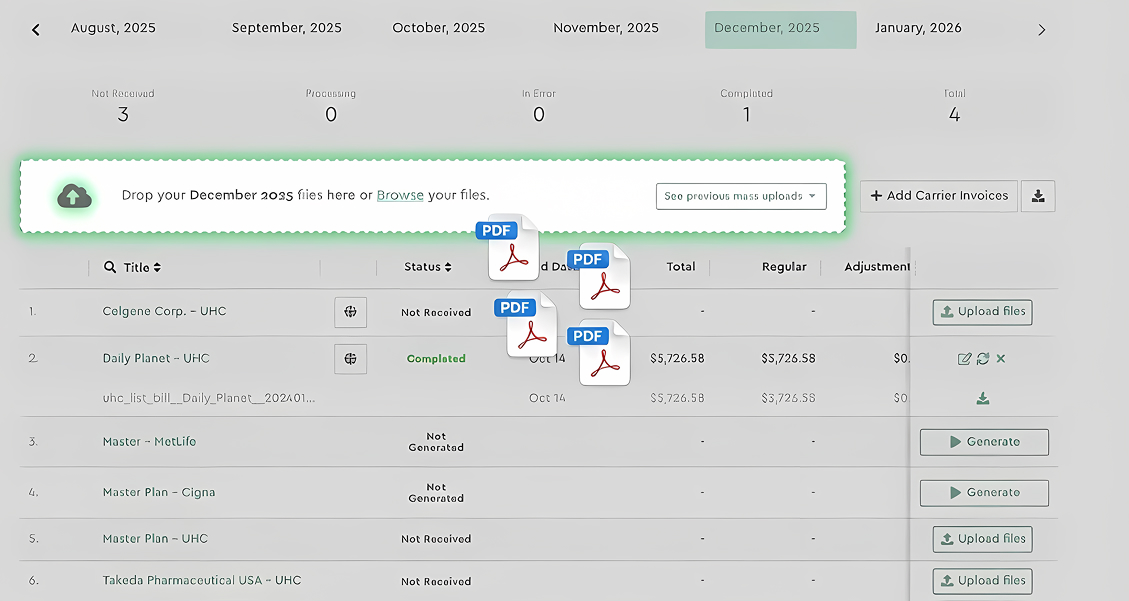Tabulera Academy
Expand your benefits premium administration knowledge with detailed tutorials
Latest articles:
Workday Consultants See the Same Reconciliation Gap Across Clients
A practical look at why benefits reconciliation still falls outside the Workday implementation, and why fixing it matters for Workday Consultants.

January 3, 2026
Faster Monthly File Uploads for Large Invoice Batches
With the new drag-and-drop upload, you can now simply drop all your monthly invoice files into the platform at once.

October 13, 2025
Your Benefits Reconciliation Spreadsheet Is Costing You More Than You Think
With 1-2% of benefit invoices containing errors, Excel-based reconciliation creates financial risk.

September 3, 2025
How-to's:
Step-by-step guides to help you get things done in Tabulera.
Learn how to configure features, run workflows, and solve common tasks.
 Reconciling Benefit Invoices against Workday Reports
Reconciling Benefit Invoices against Workday ReportsNeed to reconcile benefits invoices against Workday? This guide walks you through generating the reports inside Workday.

December 22, 2025
Learn how to upload and map Enrollment, Payroll, COBRA and Carrier Invoice Files.
Understand how to navigate Tabulera’s Reconciliation UI to resolve variances faster.
Set up plans accurately with Tabulera’s new tools.
Access carrier invoices faster with Tabulera's auto-fill extension.
Learn how to link unmatched employee records in your system.
Learn to map and merge plans and persons.
Learn to reconcile your first benefits invoice.
Product Updates:
What’s new in Tabulera. Short updates on new features, improvements, and fixes.
 Faster Monthly File Uploads for Large Invoice Batches
Faster Monthly File Uploads for Large Invoice BatchesWith the new drag-and-drop upload, you can now simply drop all your monthly invoice files into the platform at once.

December 24, 2025
Quickly regenerate invoices right from the invoice view—no extra clicks, no backtracking.
The Mass Updates of Employee Records feature in the Benefits Reconciliation Module simplifies bulk editing of employee records.
We’ve introduced a count of "In Progress" items, Notes column search functionality, multi-month invoice refresh, and color-coded employee line items.
Quickly find employee, dependent, or company data with just a few keystrokes, streamlining the process.
In August, we launched updates to the Benefits Reconciliation Module, introducing Activity Logs, Paycheck dates, and a new Source Report.
In July, we launched two important updates to the Benefits Reconciliation Module, enhancing our platform's versatility and efficiency.
Discover powerful new features in our Benefits Reconciliation Module! Generate multiple reconciliation reports effortlessly, mass-enter beginning bala
Enhanced platform security with our new Two-Factor Authentication (2FA) feature, ensuring secure access with every login.
Explore the latest enhancements in Tabulera's Benefits Reconciliation 3.2, including Manual Adjustments, Previous Period Resolved, Platform Guide.
Discover Tabulera Benefits Reconciliation 3.1: Enhanced features for streamlined reconciliation and user control.
Blogs:
Insights on benefits operations, reconciliation, and EDI.
Learn how teams reduce errors, save time, and scale their processes.

A practical look at why benefits reconciliation still falls outside the Workday implementation, and why fixing it matters for Workday Consultants.
Workday Consultants See the Same Reconciliation Gap Across Clients
January 4, 2026
With 1-2% of benefit invoices containing errors, Excel-based reconciliation creates financial risk.
This article is a must-read for brokers and agencies looking to grow their service offerings without overburdening their teams. We dive into how to su
Discover how benefits invoice audit, also known as benefits reconciliation, helps brokers catch and correct billing errors.
Explore the essential processes of enrollment and payroll reconciliations in employee benefit premium administration.
Explore the relevance of Management by Walking Around (MBWA) in the digital age of remote work. Discover the benefits and the challenges of MBWA.
Learn about the EDI 834 implementation process and the significant benefits of using EDI's for streamlined benefits enrollment.
Discover the differences between list-billing and self-billing for employee benefit plans, including their unique reconciliation processes.
Discover how our clients saved over $531,742 in just one year by implementing consolidated invoicing and benefits reconciliation.